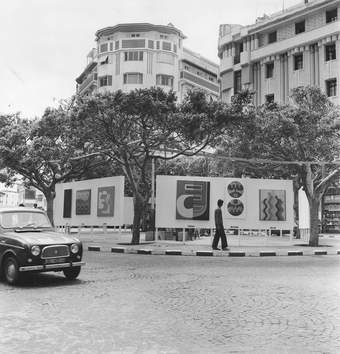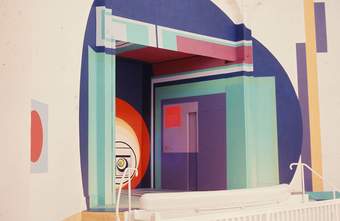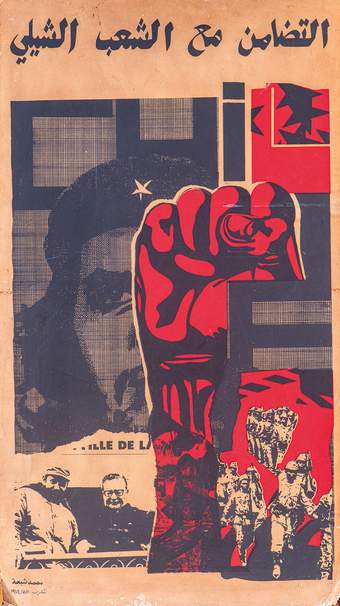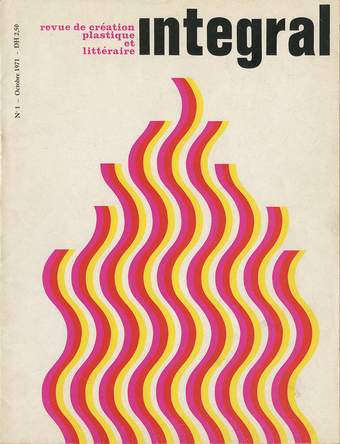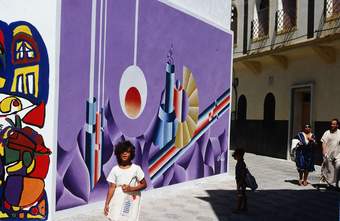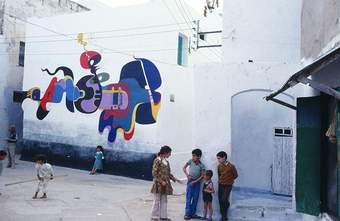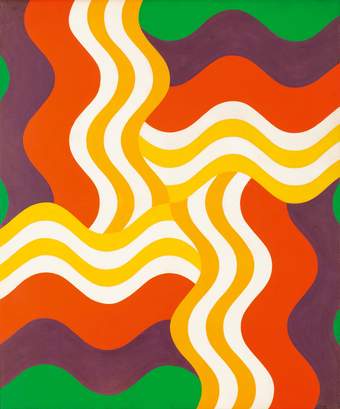
Mohamed Melehi
Composition 1970
Acrylic paint on cardboard
120 x 100 cm
In the 1960s and 1970s, in the exhilarating wake of Moroccan independence from French colonial rule in 1956, the staff and students at a revolutionary art school embarked upon a curriculum of artistic experimentation that helped to forge a new vision for the country’s visual culture and heritage.
The chief protagonists of the Casablanca Art School were the artist Farid Belkahia, the director from 1962 to 1974, and artist-tutors Mohammed Chabâa and Mohamed Melehi. They had each travelled and studied throughout Europe and the United States before making their return to the Moroccan art field. The transformative artistic experiments they both practiced and encouraged through their teaching often focused on creating a dialogue between so-called ‘Afro-Berber’ popular arts – forms of cultural expression that had been undermined by the French colonial powers pre-independence – and the artistic activities they had experienced first-hand in cities across the world, including Paris, Prague, Rome and New York. Together, they rehabilitated the skills and techniques of their country’s past, bringing them into the present, and prompting an artistic revolution that spread far into the future.
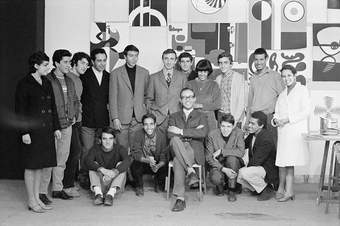
Teachers Farid Belkahia, Mohammed Chabâa and Mohamed Melehi with the Italian artist Agostino Bonalumi and painting students at the Casablanca Art School, 1965
Photo: M. Melehi. © M. Melehi archives/estate
‘Tradition is the future of man’, Belkahia used to say. During his time as director of the Casablanca Art School, he led a multidisciplinary programme, gathering around him a faculty of influential thinkers and makers. Alongside artists Chabâa and Melehi, he invited the researchers Bert Flint, a Dutch anthropologist, and Toni Maraini, an Italian anthropologist and art historian, to join the teaching staff. Together, they set about reinventing art education and theory in Morocco, combining a bold artistic vision with a committed social vocation.
One of the group’s chief aims was to overthrow the academicism of traditional easel painting. Within the school’s workshops, the medium was opened up to new possibilities by introducing strategies gleaned from the field of graphic design. Chabâa sought to redefine classical calligraphy through the art of modern typography, and his course infused painting with neo-calligraphy and decoration. His work reflects a profound knowledge of traditional Moroccan and Amazigh (the self-name for the Berber peoples) pattern making and multicolour tiles (known as zellige), while at the same time contending with the visual strategies and aesthetics of global geometric and Op art. He once said: ‘Our artistic, geometric and decorative heritage better reflects our historical mentality than any image or representation MA of “reality”.’ Meanwhile, Melehi invited his students to combine painting with collage – he even opened a pioneering photography studio – while encouraging them to explore the patterns and visual organisation of Amazigh carpets, and to evolve these forms into a new type of modern mural art.
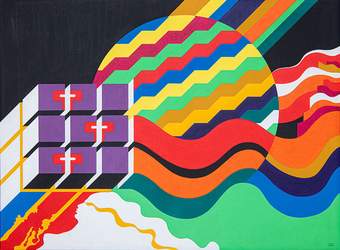
Mohammed Chabâa
Untitled 1977
Acrylic paint on canvas
75 × 95 cm
M. Chabâa Estate. © M. Chabâa Estate
Melehi’s ideas were informed by his longstanding dialogue with Bert Flint, which had begun even before they both joined the teaching staff of the Casablanca Art School in the mid-1960s. The characteristic wave patterns present in much of Melehi’s works were made in conversation with Flint’s extensive studies of traditional ornamental art, particularly his analyses of the signs and symbols found in Amazigh carpet and jewellery designs. Flint, who had started collecting traditional arts and crafts as early as 1955, upon his first arrival in Morocco, believed he had identified in these traditional forms of material culture ‘an alternative thinking to that of scientific rationality’: namely, one in which ‘each object is both utilitarian and sacred, belonging to a cosmic system of signs.’ His research, which mainly focused on the culture of the High Atlas and Anti-Atlas Mountains, also sought to reveal the fundamental role played by the Saharan populations within the multicultural heritage of Morocco. Civilisation, he demonstrated, is not only produced by urban and trading centres but also by the desert and its nomadic populations, in cultural exchanges that take place beyond national or colonial borders.
Classes suffused with these ideas laid the foundations for the work that would be produced by many of the school’s students, including that of the young artists Malika Agueznay, Abdellah Hariri and Hossein Miloudi. In 1968, they all participated in the annual Casablanca Art School student exhibition, which took place at the city’s Arab League Park Pavilion. This event signalled the pinnacle of the school’s concept of collective creativity. Chabâa and Melehi led the students to occupy the totality of the gallery, transforming it with multiple stunning, movable, painted panels. Some of these, like Agueznay’s, were monumental in scale, and, together with other large-scale trompe l’oeil décor, multiplied the potentialities of the architectural space. Further display strategies, such as placing groups of ceramics on multiple shelves – playing on the idea of a modular grid – contributed to the creation of a total geometric visual environment.
In the show’s brochure, Toni Maraini, who had arrived at the Casablanca Art School in 1964 to establish the first modern art history course in Morocco, outlined three of the school’s main goals: ‘the understanding and practical knowledge of integrated and applied arts’; a reawakening to ‘the notion of anonymous and collective creation’ inspired by ‘the traditional artistic past’; and, finally, the search for ‘a future perspective’ that would reflect ‘the reality of a country that is being built’. This would be one in which the artist is called to be an active participant in social and economic reform. Her words echoed the vision of the earlier Bauhaus school in Germany, in which distinctions between art, craft, design and architecture were removed, and the artist was regarded as, in the words of its founder Walter Gropius, an ‘inspired artisan’.
The following year, in 1969, the manifesto exhibition Présence Plastique (Plastic Presence) took place in two different locations, a few weeks apart: in Jemaa el-Fna Square, Marrakech in May, and in Casablanca’s 16 November Square in June. The exhibition’s nomadic nature was extended further in 1971 as it toured to the high schools of Casablanca to reach out to a younger audience. A defining moment in the history of art in Morocco, and for modernist art in the Global South more generally, it brought together the school’s core trio of Belkahia, Chabâa and Melehi with three other artist-facilitators from the school, Romain Ataallah, Mustapha Hafid and Mohamed Hamidi.
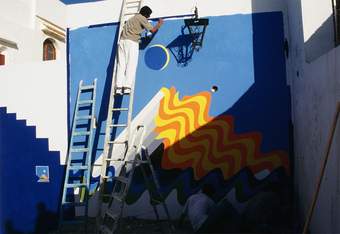
Mohamed Melehi painting a mural at the first Asilah Cultural Moussem-Festival, 1978
© M. Melehi archives/estate
Held in opposition to the state-sponsored Salon du Printemps (Spring Salon) that was taking place in Marrakech at the same time, and in defiance of the enduring colonial ideology that categorised Moroccan artists as ‘naïve painters’, the exhibition was a calculated attack on the country’s slow cultural evolution: more than ten years since independence, nothing had been organised for and by Moroccan artists to enhance their visibility or to make modern ara key element in the everyday life of the community. The participating artists outlined their ambitions regarding public engagement in an unsigned tract that was distributed to passers-by:
People from all walks of life (urban, rural, and every social class) gather in a unique state of mind. We hung our works here for ten days … To show works outside of the closed doors of galleries and salons, where this audience had never been, and never felt the impact of any manifestation behind closed doors. Works that undergo the same atmospheric variations as do the people, the walls, the entire square.
At the heart of the group’s political and aesthetic pursuit to bring art out from ‘behind closed doors’, and to integrate it into people’s lives, was the creation and organisation of alternative platforms for exhibiting and distributing their art. These radical outlets included the journal, the poster, the street, as well as collaborations with architects.
One of these, the journal Souffles, ran from 1966 to 1972 and was initially co-designed by Chabâa and Melehi. It was founded by the poet Abdellatif Laâbi as a militant and poetic platform with a mission to decolonise the arts and democratise the cultural field. From 1971, Chabâa became its sole graphic designer, turning it into a radical anti-imperialist platform, until he was imprisoned by the Moroccan authorities who were, at the time, suppressing Marxist activists. Melehi left Souffles in 1971 to found Inte-gral, an influential ‘journal of plastic and literary creation 'for which he acted as a photographer, editor and artistic director. Meanwhile, Chabâa also established a graphic and interior design studio, Studio 400, that worked with national companies and private hotels. Melehi, in turn, opened Shoof, a publishing and graphic design studio which played a key role in the documentation of the Moroccan modern movement. They both created poster and logo designs that reflected their political commitments, such as their solidarity with the Angolan or Palestinian people and resistance movements. Their efforts in these fields reflected the belief, in Melehi’s words, that: ‘Any type of art, if used as a way of communication, is a way of awakening attitudes, can help broaden minds.
Extending their influence further afield, in March and April 1974 a strong Moroccan delegation composed of the Casablanca artists’ network (Chabâa and Melehi, as well as Belkadi, Ben Seffaj, Ghattas, Hafid, Hamidi and Kacimi) participated at the first Arab Art Biennial in Baghdad, Iraq. As Toni Maraini recounted in a special issue of Integral dedicated to the biennial, the group stood out for their sharp artistic and political stance, which made no concessions to a reactionary socialist realist style and iconography.
A few years later, in 1978, Melehi and politician Mohamed Benaïssa, then a member of the town’s council, co-founded the Cultural Moussem of Asilah festival in the north of Morocco – their homeland. Together, they turned Asilah into a veritable artistic promised land, especially for mural art. The event also featured painting, sculpture, and ceramics exhibitions, engraving studios, workshops for children led by Toni Maraini, and a great number of lectures, theatre and concerts. This led to the establishment of an annual international festival that, to this day, transforms the town’s streets into a vibrant open-air museum.
Nowadays, the Casablanca Art School is acknowledged as a major force in the development of modernist art in the Global South. Its experimental approach to art education oversaw a heady period of artistic rebirth in Morocco, paving the way for a new generation of socially engaged modern artists who, in turn, formed an influential avant-garde network that would extend beyond the country’s borders. From Havana to Baghdad, the works of the school’s teachers and students circulated globally in a world marked by independence movements and anticolonial struggles. In their commitment to bringing art out into the light, under the same skies as the public it wanted to reach, this Moroccan ‘new wave’ also triggered an urban social movement that would later help to build artistic solidarities between Latin American, West Asian and African countries, bridging the gap between postcolonial and a truly global art history.
The Casablanca Art School, Tate St Ives, 27 May 2023 – 14 January 2024. Curated by Morad Montazami and Madeleine de Colnet for Zamân Books & Curating in conjunction with Anne Barlow, Director, Tate St Ives and Giles Jackson, Assistant Curator, Tate St Ives, and with associate researchers Fatima-Zahra Lakrissa and Maud Houssais. The exhibition is supported by the Casablanca Art School Exhibition Supporters Circle and Tate Members. This exhibition is a partnership between Tate St Ives and Sharjah Art Foundation, where it will open in February 2024. It is also part of a key moment of international research into the Casablanca Art School, which includes a collaborative project initiated in 2020 between KW Institute for Contemporary Art and Sharjah Art Foundation, in partnership with Goethe-Institut Marokko, ThinkArt and Zamân Books & Curating.
Morad Montazami is the director of Zamân Books & Curating, a publishing and curatorial platform dedicated to the study of Arab, African and Asian modernism.

